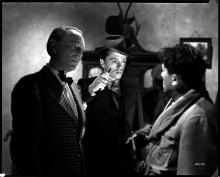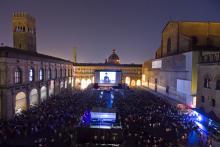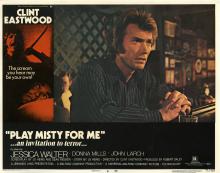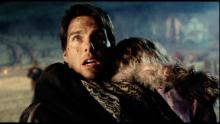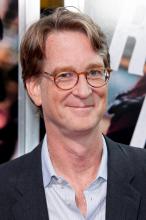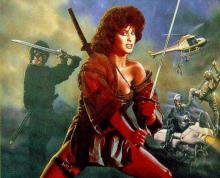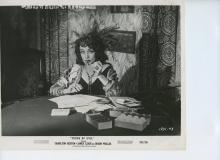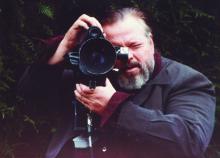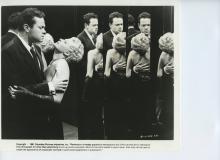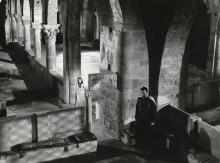These notes on the Boulting Brothers' Brighton Rock (1948) were written by Cinematheque Programmer and Project Assistant Amanda McQueen. A 35mm print of Brighton Rock from Rialto Pictures will screen on Saturday, March 28, at 7 p.m. in 4070 Vilas Hall. The screening is the first of two that highlight the superb villainy of the late actor Richard Attenborough.
By Amanda McQueen
When Lord Richard Attenborough passed away in August 2014 at the age of 90, he left behind a career as an actor, producer, and director spanning an impressive 65 years – from his first minor role in 1942 to his final directorial feature in 2007. His diverse filmography holds no shortage of excellent performances, but one of his earliest is routinely singled out: juvenile gangster Pinkie Brown in Brighton Rock (1948). Although initial reception of the film was mixed, it has since become a canonized classic of British cinema, in no small part because of Attenborough's performance.
Graham Greene's 1938 novel Brighton Rock was adapted for the screen ten years after the book’s publication by twin brothers John and Roy Boulting; John acted as director, Roy as producer. Greene, in collaboration with Terence Rattigan, wrote the screenplay. Thanks to its literary origins and the strong reputation of the Boutling brothers, Associated British Picture Corporation (ABPC) – second only to the Rank Organization in terms of industrial clout – assigned the project a budget of £178,000, a mid-sized budget for the time but more than was generally allotted for a gangster picture. For ABPC, Brighton Rock was primarily a genre film – another entry in the popular post-war cycle of crime films – not a prestigious literary adaptation. Nevertheless, the Boultings were given a great deal of freedom during production and a lengthy shooting schedule of nearly six months.
Greene believed that films were most effective when they fused melodrama with realism, and the Boultings, known for cinematic depictions of social issues, concurred. The events depicted in the film were rooted in the real-life criminal underworld of 1930s Britain, when illegal cash gambling was a huge industry controlled by corrupt officials and gangs armed with straight razors. The seaside resort of Brighton, with its lavish hotels and racetrack, was a particularly notorious site for adultery, illicit gambling, and murder (despite assertions to the contrary, the town's reputation had not changed by 1948). For Greene, Brighton's contrasting sides – its bright, sophisticated exterior and its seedy underbelly – made it the ideal setting for an examination of good and evil. Brighton Rock’s production team thus sought to convey the town’s symbolic duality while also keeping the action rooted in a realistic world.
Creating an authentic Brighton on screen was accomplished in part through location shooting. Contrary to popular myth, however, the bulk of the film was shot at ABPC's small studio at Welwyn and on MGM's large soundstages at Elstree, where Brighton landmarks like the Cosmopolitan Hotel and the seaside promenade were meticulously recreated. It’s a testament to John Howell’s art direction, Harry Waxman’s cinematography, and Peter Graham Scott’s editing that the location footage and studio footage are so seamlessly combined. To further assist in the creation of a believable criminal milieu, Roy Boulting brought in Carl Ramon, a card shark and ex-member of the Sabini gang, which had ruled Brighton Racecourse in the 1930s. It was Ramon who would instruct Attenborough on how to speak, walk, and dress like an authentic spiv.
Attenborough also had the advantage of having played Pinkie before. The stage version of Brighton Rock opened in the West End in 1943. Greene had wanted an unknown actor for the lead, and the twenty-year-old Attenborough, a recent graduate of the Royal Academy of Dramatic Art with only two minor film roles under his belt, was just that. Greene was initially unsure whether the actor's round, boyish face could connote the required evilness of the character, but Attenborough quickly won him over. His strong stage performance and the close relationship he formed with the Boultings during their time together in the RAF Film Unit assured that he would be brought in to reprise the role on film (Attenborough wasn't the only import, however; five other actors came with him from the stage version). With John Boulting's help, Attenborough learned how to tailor his performance to the intimacy of the screen and realistically convey his character's complex psychology. But while some contemporary reviewers believed that "Attenborough's performance . . . is so good that one loses all sense of its being a performance," not everyone agreed. The Daily Express famously quipped that "the film version of Pinkie is about as close to the real thing as Donald Duck is to Greta Garbo."
The range of responses to Attenborough's Pinkie were part of a larger debate about the fidelity of Brighton Rock to its source material. Adapting Greene's dark, heavily symbolic tale to the screen had not been easy. When he discovered that the theatrical adaptation had softened his novel's ending, Greene was furious. Yet he also stated that the original ending was too bleak for mainstream commercial cinema and approved Rattigan's suggestion to give Pinkie's wife Rose (Carol Marsh) a moment of happiness at the film's conclusion. Complaints that Brighton Rock lost something in translation might also derive from the fact that distributor Pathé insisted on cutting several scenes to make the film run a tight 92 minutes and fit on a double bill. Some have argued that by deleting expository scenes explaining Pinkie's background, the film becomes more thriller than social drama. Rather than being seen as a product of his poverty and upbringing, Pinkie is reduced to a monster, pure and simple. Finally, Brighton Rock was replete with violence and references to Catholicism, neither of which made it past the British Board of Film Censors completely intact. But even in its approved, somewhat diluted form, Brighton Rock was too brutal for some tastes. Daily Mirror film critic Reg Whitley condemned it as "false, cheap, nasty sensationalism" that no woman would go to see. The rate of adolescent incarceration was also rising rapidly in Britain, and many thought that popular entertainment should portray positive values, not razor-wielding teenage delinquents.
Of course, controversy often helps box office, and Brighton Rock was one of ABPC's top grossing films of the year. But its success was limited to the domestic market. Pathé worried the film wasn't exportable, even briefly changing its title to The Worst Sin out of concern that foreign audiences wouldn't be familiar with Brighton and the hard candy to which the titular "rock" refers. Foreign censor boards also posed a problem. Brighton Rock was banned in Holland, and ABPC didn't even submit the film to Hollywood's Production Code Administration, fearing it would demand additional cuts. Warner Bros., part-owner of ABPC, refused to distribute the film without a PCA seal, and so Brighton Rock didn't make it to America until 1951, when indie distributor Mayer-Kingsley gave it a limited release (without PCA approval) under the title Young Scarface.
Over time, Brighton Rock has come to be seen as a film ahead of its time in terms of performance and style. In 1999, it placed 15th on the BFI's poll of the 100 best British films of the 20th century, having been embraced as a brilliantly chilling depiction of the nation's dark side. And although the role of Pinkie Brown caused Attenborough to be typecast for a number of years as a spiv and a baby-faced teenager, there is little doubt that it launched the career of a man who would become an institution of the British film industry.

